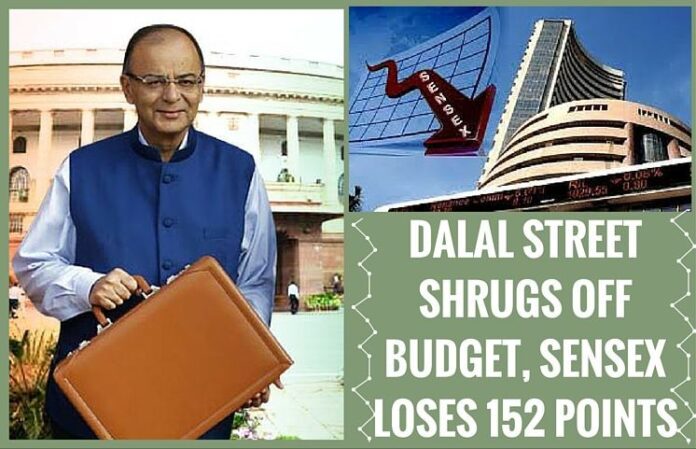
Sensex down 152 points, Budget disappoints equity markets
The Indian equity markets on Monday were depressed due to the Union Budget announcements combining the effects with negative global cues.
As the result, Bombay Stock Exchange’s (BSE) 30- scrip sensitive index (Sensex) ended the day’s trade in the red.
[dropcap color=”#008040″ boxed=”yes” boxed_radius=”8px” class=”” id=””]C[/dropcap]orrespondingly, the Nifty’s 50-scrip of National Stock Exchange (NSE) also closed its day’s trade lower. It came down by 43 points or 0.61%, to 6,987.05 points and Nifty touched its fresh low of 6825.80 during the day.
The Sensex also went down by 152.30 points or 0.66% from the previous day’s close at 23,154.30 points. It opened on Monday at 23,238.50 points and closed at 23,002 points.
Sensex saw its fresh 52-week low during the intra-day trade, where it touched a high of 23,343.22 points and low of 22,494.61 points.
Initially, the Indian equity markets opened on a negative note, as investors were seen cautious over the Union Budget 2016-17 and downturn in Asian indices.
The Union Budget 2016-17 was tabled in parliament by Finance Minister Arun Jaitley, whose tax proposals for the next fiscal depressed investors’ sentiments.
The key equity indices dipped to their fresh 52-week lows, as Jaitley proposed to hike the securities transaction tax (STT) on options trade from 0.017 percent to 0.05 percent.
“Rate of securities transaction tax in case of ‘Options’ is proposed to be increased from 0.017 percent to 0.05 percent,” Jaitley announced.
Further, the minister proposed a tax at the rate of 10 percent on gross amount of dividends which are in excess of Rs.10 lakh ($14729) per annum.
[dropcap color=”#008040″ boxed=”yes” boxed_radius=”8px” class=”” id=””]D[/dropcap]”ividend Distribution Tax (DDT) uniformly applies to all investors irrespective of their income slabs. This is perceived to distort the fairness and progressive nature of taxes,” the minister informed the Lok Sabha.
“Persons with relatively higher income can bear a higher tax cost. I, therefore, propose that in addition to DDT paid by the companies, tax at the rate of 10 percent of gross amount of dividend will be payable by the recipients, that is, individuals, HUFs (Hindu undivided family) and firms receiving dividend in excess of Rs.10 lakh per annum.”
Notwithstanding the down trend, markets briefly recovered from the day’s low, as Jaitley announced that fiscal deficit target was maintained.
According to market observers, fiscal prudence heightened chances of a future rate cut by the Reserve Bank of India (RBI).
In addition, an even lower fiscal deficit target gave strength to the Indian rupee.
The rupee which opened on a weak note, however, strengthened by 21 paise at close. It ended the day’s trade at 68.42 to a US dollar from its previous close of 68.62-63 to a greenback.
Furthermore, the minister disclosed the government’s expenditure figures on rural sector, infrastructure development, crop insurance, agricultural credit, skill enhancement and start-up initiative.
[dropcap color=”#008040″ boxed=”yes” boxed_radius=”8px” class=”” id=””]M[/dropcap]”arkets were disappointed, as investors expected some out-of-box reform measures. However, the budget did provide some major reform measures, as well as healthy fiscal deficit targets,” Anand James, co-head, technical research desk with Geojit BNP Paribas Financial Services, told IANS.
“Roads and infrastructure sector were supported.”
Vaibhav Agarwal, vice president and research head at Angel Broking, elaborated that “there were some big negatives like the hike in securities transaction tax and lower bank recapitalisation levels.”
“Big positives included the hike in rural spending and infrastructure sector,” Agarwal noted.
Devendra Nevgi, chief executive of ZyFin Advisors, said: “More rational budget in the long term, rightly focussing on infrastructure, rural economy, social sectors, education, health, financial sector etc.”
[dropcap color=”#008040″ boxed=”yes” boxed_radius=”8px” class=”” id=””]T[/dropcap]”he bottom of the pyramid is targeted, which is good for the long term. Markets will now focus on execution which remains the key. Fiscal deficit targets for next year is positive for bond markets.”
At the end of the day’s trade the foreign institutional investors (FIIs) had divested Rs.2,018.02 crore ($295.63 Million), while the DIIs (domestic institutional investors) bought stocks worth Rs.1,445.25 crore ($211.72 Million).
Sector-wise, S&P BSE banking index augmented by 167.21 points, healthcare index gained by 35.53 points and finance index edged up by 28.05 points.
In contrast, the S&P BSE capital goods index plunged by 228.53 points, IT index receded by 220.07 points and consumer durables index declined by 197.26 points.
Major Sensex gainers during Monday’s trade were ICICI Bank, up 2.79 percent at Rs.190 ($2.79); Reliance Industries, up 1.69 percent at Rs.966.55 ($14.22); ITC, up 1.65 percent at Rs.295.80 ($4.35); Lupin, up 1.42 percent at Rs.1,752.15 ($25.79); and State Bank of India (SBI), up 1.38 percent at Rs.158.40 ($2.33).
Major Sensex losers during the day’s trade were ONGC, down 9.72 percent at Rs.194.10 ($2.85); Maruti Suzuki, down 4.88 percent at Rs.3,242.60 ($49.74); BHEL, down 4.21 percent at Rs.91.10 ($1.34); Infosys, down 3.33 percent at Rs.1,083.75 ($15.95); and Larsen and Toubro (L&T), down 2.83 percent at Rs.1,079.25 ($15.89).
About Dalal Street
Here is an informative post on Dalal Street.
Notes:
1. IANS
2. The conversion rate used in this article is 1 US Dollar = 68.26 Rupees
- Pentagon cancels aid to Pakistan over record on militants - September 2, 2018
- The curious case of Tamil Nadu’s opposition to NEET - September 4, 2017
- If 2.6 Billion People Go To War: India vs. China - July 22, 2017











SENSEX, the drop yesterday and the dramatic rally today – has it something to do with the role of promissory notes as being explained by Dr. Swamy in many his meetings?? I won’t be surprised. Nothing has happened for the steep rally today